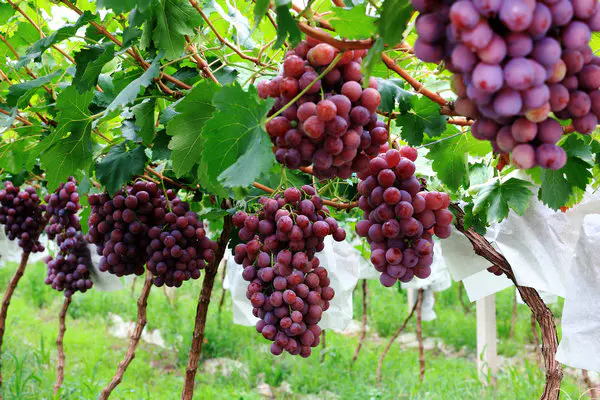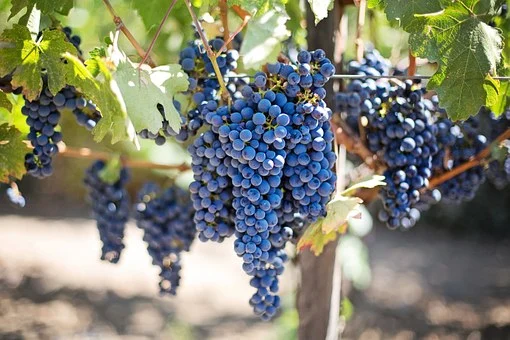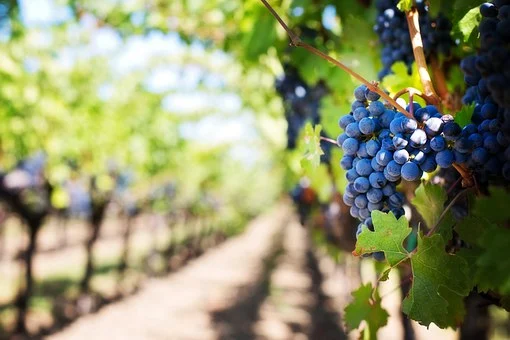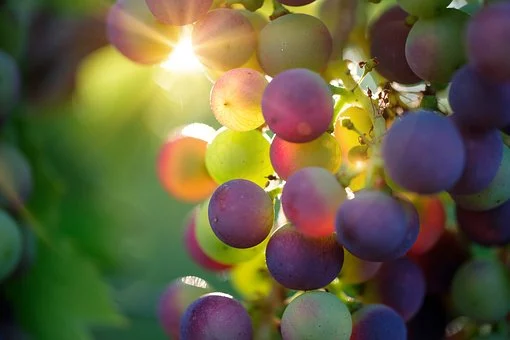How to Grow and Care for Concord Grapes
Written by Ivy
Nov 11 2021

Concord grapes is a native red grape variety native to the United States. The birth of this Concord grapes variety was closely related to a resident of Massachusetts Concord named Ephraim Wales bull: in 1840, several little boys scattered the seeds of wild grapes growing by the river near Ephraim's house. These seeds eventually grew a vine, so Ephraim harvested the first bunch of grapes in 1843. After that, he planted new vines with the seeds of this bunch of grapes. These vines had excellent fruit quality and were later named Concord grapes.

Under the condition of sufficient light, the growth is robust and the physiological activities are gradually enhanced. The nutritional status can be greatly improved and the damage of diseases and pests can be reduced. It can greatly improve the yield and quality, and there will be insufficient light in rainy days in life.
If Concord grapes can't get the required light for a long time, the quality of grapes will be reduced and the color will become lighter. However, we need to supplement the light when the light is insufficient.
The temperature of Concord grapes during flowering should be more than 15 degrees. If the temperature is lower than this, it will lead to poor pollination and even a large number of flowers and fruits.
Especially for those precocious Concord grapes, the control of temperature and humidity is the key, and the temperature should not be too high or too low. Low temperature or insufficient light will greatly affect the taste of Concord grapes, low sugar content and low yield.
Control methods: completely remove diseased ears, vines and leaves to reduce bacterial sources. In the south of the Yangtze River, bagging can be carried out immediately after flower fading; Strengthen the cultivation management, timely adjust the school, tie the vine and pick the heart, ventilate the shelf surface, increase the application of phosphorus and potassium fertilizer, and control the amount of nitrogen fertilizer.
Control method: completely remove the diseased branches and vines, diseased ears and diseased leaves; Prune in time, raise the bearing part, weed in time, pay attention to drainage, and do not apply nitrogen fertilizer to the overgrown plants before flowering.
Control methods: remove fallen leaves, explore and bury diseased branches or burn them; Timely pick the heart, prune, drain and weed, and increase the application of phosphorus and potassium fertilizer; Spraying should be started in the early stage of onset. In the north, spraying should be started in the first and middle of June and every 15 days; Before the onset of Concord grapes disease, Bordeaux liquid has the best control effect.
We can choose a few ripe grapes, remove the skin and pulp, and take out the seeds inside. Wash the juice and residual pulp, keep them for standby, and then store them in a cool place. Pay attention to ensure that the environment is dry.
In the first two months of Concord grapes singing propagation, we can wrap the seeds in wet sand and adjust the appropriate temperature for sand storage. During this period, if the temperature exceeds 5 ℃ or the humidity exceeds 10%, the seeds need to be turned over to prevent mildew.
Wait until early spring, we can select well-developed seeds and sow them evenly in the soil.
Resveratrol contained in Concord grapes can prevent canceration of normal cells, inhibit the proliferation of malignant cells, prevent atherosclerosis, adjust blood lipids, inhibit platelet coagulation, reduce blood viscosity and enhance immune ability. Concord grapes has a strong antioxidant and anti-aging substance called procyanidins. The efficacy of procyanidins is several times higher than that of vitamin C and vitamin E.
Concord Grapes Quick InfoWhen to Plant Concord GrapesWhen does Concord Grapes Bloom & HarvestConcord Grapes Care in DetailConcord Grapes WateringConcord Grapes SoilConcord Grapes LightConcord Grapes TemperatureConcord Grapes HumidityConcord Grapes FertilizerConcord Grapes PruningConcord Grapes RepottingConcord Grapes Pest & Disease ControlAnthraxWhite rotDowny mildewConcord Grapes PropagationConcord Grapes Propagation from CuttingConcord Grapes Propagation from SeedConcord Grapes Benefits
Concord Grapes Quick Info
| Botanical/Scientific Name | Vitis Labrusca |
| Common Name | Fox Grape |
| When to Grow/Bloom/Harvest | Plant in early spring/Flowers bloom in spring/Full crop during the fourth summer |
| Uses | Make grape jelly, grape juice, grape pies, grape-flavored soft drinks, and candy. |
| Origin | New England |
| Light Care | Partial shade is acceptable |
| Soil Care | Nutrient rich, well-drained soil |
| Temperature Care | Over 50 degrees Fahrenheit |
| Humidity Care | High humidity about 90-95 percent |
| Watering | Be watered weekly |
| Pruning Care | Regular pruning and maintenance throughout the growing season |
| Fertilizer Care | Well-balanced fertilizer |
| Propagation | Through dormant cuttings |
| Toxic | Poisonous to dogs |
| Flower Color | Bright orange flowers |
When to Plant Concord Grapes
Generally speaking, the season suitable for planting Concord grapes is spring, because the climate is relatively good and grapes are well developed. However, many fruit farmers also choose to plant grape seedlings in autumn. The reason is that the planting time in autumn is relatively long, and the planting results of Concord grapes in autumn are earlier, and fruit setting can begin in the second year. Moreover, the temperature change in autumn is relatively stable, and the temperature difference in spring will be greater.When does Concord Grapes Bloom & Harvest
Concord grapes maintains the whole process from flowering to falling for four to fourteen days, and most vines take seven to twelve days. The whole process should ensure appropriate temperature and sufficient nutrients, and pay attention to pest control. After planting Concord grapes seedlings, they will blossom and bear fruit in only 2-3 years. But if the saplings are too weak, only ten clusters of grapes are left on each vine. As long as you manage properly in the later stage, Concord grapes will bear fruit in the second year.Concord Grapes Care in Detail

Concord Grapes Watering
We should water Concord grapes frequently. Generally, we should water it once a day during the growth period. In summer, when it is high temperature, we can water it twice a day to keep the basin soil moist, but there should be no ponding. Drought should be avoided after fruit setting, otherwise it is easy to drop fruit. For plants just bought home, they generally do not need to be watered immediately. If it is necessary to transplant Concord grapes, we should pour water once after putting on the pot, and the water should be poured at the root.Concord Grapes Soil
Sandy loam is the first choice for planting Concord grapes, because sandy loam is relatively soft and conducive to rooting. Moreover, it has good air permeability, which is conducive to the respiration of Concord grapes roots. Other soils have been artificially improved and can also be suitable for grape growth. After grape planting, through the early scientific management, the tree potential is well maintained and deep-rooted, which can benefit for many years or even life in the future.Concord Grapes Light
Concord grapes is a light loving plant. Its growth is closely related to light. Light is a survival factor that plays an important role in any plant, especially Concord grapes is very sensitive to light.Under the condition of sufficient light, the growth is robust and the physiological activities are gradually enhanced. The nutritional status can be greatly improved and the damage of diseases and pests can be reduced. It can greatly improve the yield and quality, and there will be insufficient light in rainy days in life.
If Concord grapes can't get the required light for a long time, the quality of grapes will be reduced and the color will become lighter. However, we need to supplement the light when the light is insufficient.
Concord Grapes Temperature
Concord grapes, like human beings, know both cold and hot. The temperature required at different growth stages of crops is also different. For example, the temperature of Concord grapes should be 10 to 12 degrees in the germination stage and 20 to 25 degrees in the new shoot stage.The temperature of Concord grapes during flowering should be more than 15 degrees. If the temperature is lower than this, it will lead to poor pollination and even a large number of flowers and fruits.
Especially for those precocious Concord grapes, the control of temperature and humidity is the key, and the temperature should not be too high or too low. Low temperature or insufficient light will greatly affect the taste of Concord grapes, low sugar content and low yield.
Concord Grapes Humidity
We should have enough water supply during the growth period of new shoots of Concord grapes, but we should drain water in time when the rainfall is excessive, so as not to let the humidity of Concord grapes be too high. If there is too little rain, it is necessary to water every ten days, otherwise fruit cracking is easy to occur in case of long drought and rain, affecting the harvest and causing economic losses. Generally, except swamp and heavy saline alkali land, other types of soil can be, and fertile sandy loam is the best.Concord Grapes Fertilizer
During the propagation of Concord grapes, we should timely supplement fertilizer according to the growth situation. Sufficient nutrition is required for fruit expansion. According to the physiological and nutritional characteristics of fruit expansion period, organic fertilizer is mainly used. The combination of underground root Topdressing and foliar spraying can achieve the effect of expansion and coloring, meet the needs of nutritional elements during fruit expansion period, improve yield and quality.Concord Grapes Pruning
During the maintenance of Concord grapes, the most important thing we need to do is concord grapes pruning. As we have emphasized above, the purpose of pruning is to control the number of branches of the grape tree and concentrate nutrients on the growth and development of its roots, so as to make the grape tree grow more vigorously in the coming year. As for pruning, we have three ways. The first way is short cutting. When we are in Concord grapes pruning, we must pay attention to that the place where the scissors are lowered should be far away from the bud eye. If it is too close, it will affect the growth and development of the bud eye in the coming year. Then we should pay attention to determine the number of buds according to the length of the treetop.Concord Grapes Repotting
Concord grapes repotting time is mostly carried out before germination in early spring or during the whole dormancy period from defoliation to germination. First prepare the sterilized culture soil, then take out the grape plant from the basin, remove the old basin soil on the plant, cut off or shorten some old roots and fibrous roots curled too long along the basin wall, cut off the dead roots, and properly cut the dense long roots. When we want Concord grapes repotting, we should pay attention to the flat cut during root pruning, so that the root system can resume growth. After pruning, plant the grape plants with new culture soil in the original basin or a larger new basin. For the plants just completed Concord grapes repotting, management should be strengthened to keep the basin soil moist, increase the basin soil temperature, promote the root system to resume growth as soon as possible, and make the whole plant renew, rejuvenate and grow healthily.
Concord Grapes Pest & Disease Control
Anthrax
This Concord grapes disease can generally invade and come on from June, and the peak period is from July to August. The disease is getting worse and worse in the near mature period. Before and after August 10, due to a large number of mature fruits, the disease enters the peak period every hot thunderstorm.Control methods: completely remove diseased ears, vines and leaves to reduce bacterial sources. In the south of the Yangtze River, bagging can be carried out immediately after flower fading; Strengthen the cultivation management, timely adjust the school, tie the vine and pick the heart, ventilate the shelf surface, increase the application of phosphorus and potassium fertilizer, and control the amount of nitrogen fertilizer.
White rot
In high temperature, high humidity and rainy seasons, the disease is serious, and the disease peak occurs after rain. In the north, it can occur from June to harvest period. The disease increases during fruit coloring period, and the disease peak occurs after storm. The disease is serious near the ground and under the conditions of heavy soil viscosity, low-lying terrain and poor drainage. It is easy to occur when weeds are overgrown, branches and leaves are closed or humidity is high, Partial prosperous and overgrown plants are prone to disease.Control method: completely remove the diseased branches and vines, diseased ears and diseased leaves; Prune in time, raise the bearing part, weed in time, pay attention to drainage, and do not apply nitrogen fertilizer to the overgrown plants before flowering.
Downy mildew
This Concord grapes disease is easy to occur in rainy, dew and low temperature in autumn. The orchard has poor ventilation, high humidity and more nitrogen fertilizer, which is conducive to the disease. It usually occurs in June in the north, and the peak period is from August to September. In the south of the Yangtze River, there are 2-3 disease peaks in the whole year.Control methods: remove fallen leaves, explore and bury diseased branches or burn them; Timely pick the heart, prune, drain and weed, and increase the application of phosphorus and potassium fertilizer; Spraying should be started in the early stage of onset. In the north, spraying should be started in the first and middle of June and every 15 days; Before the onset of Concord grapes disease, Bordeaux liquid has the best control effect.

Concord Grapes Propagation
Concord Grapes Propagation from Cutting
Concord grapes propagation by cuttings is usually carried out in early summer, specifically between June and July. At this time, the climate is more suitable and conducive to the rooting and growth of branches. In addition, it can also be carried out in spring. Specifically, between late March and mid April, hard branches are used as cuttings, but the rooting time is long, and the survival rate is not as high as that of cuttings in summer.
In Concord grapes cutting propagation, we should use lignified new shoots as cuttings, and cut them into small segments of about 30 cm. We should pay attention to the flat shear at the upper end and the inclined mouth at the lower end. In addition, the upper leaves should be cut off, leaving only one. And the buds are yellow and white, which is better, and can grow faster after insertion.
Concord Grapes Propagation from Seed
The best choice is from March to April at the beginning of spring. Early spring is good for the growth of grape seeds during plant growth and development.We can choose a few ripe grapes, remove the skin and pulp, and take out the seeds inside. Wash the juice and residual pulp, keep them for standby, and then store them in a cool place. Pay attention to ensure that the environment is dry.
In the first two months of Concord grapes singing propagation, we can wrap the seeds in wet sand and adjust the appropriate temperature for sand storage. During this period, if the temperature exceeds 5 ℃ or the humidity exceeds 10%, the seeds need to be turned over to prevent mildew.
Wait until early spring, we can select well-developed seeds and sow them evenly in the soil.
Concord Grapes Benefits
When Concord grapes is mature, the fruit is purple black, the peel is thin, the taste is sour and sweet, and the juice yield is very high. It is generally used to make high-grade grape juice. Total phenol is recognized as one of the strongest antioxidants with the best anti-aging effect. The content of total phenol in pericarp (colored varieties) and grape seeds of Concord grapes is higher than that of green grapes.Resveratrol contained in Concord grapes can prevent canceration of normal cells, inhibit the proliferation of malignant cells, prevent atherosclerosis, adjust blood lipids, inhibit platelet coagulation, reduce blood viscosity and enhance immune ability. Concord grapes has a strong antioxidant and anti-aging substance called procyanidins. The efficacy of procyanidins is several times higher than that of vitamin C and vitamin E.
Latest Updated
- Benefits of Bugleweed - 7 Science-backed Health Benefits
- Bugleweed Dangers & Side Effects - Is It Poisonous?
- How to Plant Evergreen Trees - What You Should Know
- When to Plant Evergreens - Grow Guide for Evergreen Trees
- 12 Wonderful Evergreen Shrubs for Your Garden
- 12 Popular Evergreen Plants with Pictures for Beginners
- When And How To Prune A Lilac Bush Like a Pro
- How to Grow & Care for Lilac Vine (Hardenbergia Violacea)
- Japanese Lilac Tree (Syringa Reticulata) Care & Propagation Guide
- Shumard Oak Pros and Cons - What to Know
Popular Articles
- Winter maintenance of Antirrhinum Majus
- How to Grow Terminalia Mantaly Tree
- How to Grow and Care for Crossostephium Chinense
- How to grow Antirrhinum Majus in spring
- Peristeria Elata (Dove Orchid) Profile: Info & Care Guide
- Underwatered Snake Plant (Sansevieria Trifasciata) - Signs And How To Fix
- How to Care for Brazilian Jasmine Plant (Mandevilla Sanderi)
- How to Grow & Care for Graptopetalum Purple Delight in Summer
- Rosa Chinensis (China Rose): Plant Growing & Care Tips
- How to Care for Baby Sun Rose (Aptenia Cordifolia)